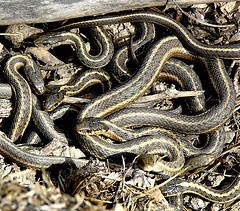Experiencing
It was a late September day. A clear blue sky formed a beautiful canopy over a chilly morning as I set out for French Creek to see what was happening. I elected to take the short cut across the grassy field next to the cement mixing plant even though I risked getting wet in the dewy grass. But this would be just one more time I wouldn’t mind getting my shoes wet until I got home and faced an irate mother.
As I entered the field I found the ankle-high wild grass, now reduced to autumnal brown, wasn’t wet at all. It was covered with white frost and it made a pleasant crackley crunchy sound as I stepped on it. I walked for a ways then turned back to see how far I’d come. The morning sun shining toward me at a low angle gave the whole field an interesting glow of brown frosted with white. And there were my footprints, each one a dark patch in the grass, irrefutable evidence that I had passed through and destroyed the pristine view that had existed just minutes before.
Continuing on my way, scanning the ground ahead, I saw a garter snake stretched out in the grass. I expected it to take off as I got closer but it did not move even a little bit. I was now beyond the reflexive “kill all snakes” attitude of my Froggy Pond days and was curious as to why this dead snake was here in the open. I walked over and gently pushed it with my toe. It didn’t move. I bent down and picked it up. It felt cold and it was very stiff. I figured it had frozen to death.
For some unknown reason I decided to take the snake with me, perhaps for close up examination later. I folded it up and put it in my pants pocket.
Before I reached the far side of the field, which was about a hundred yards, I felt movement in my pocket. The snake wasn’t dead as I had assumed. Though I was no longer into killing snakes, having a live one in my pocket was a little scary. I carefully reached in and brought out the snake. In human terms I would describe it as groggy, maybe hungover; moving, but very slowly.
So the snake had just been cold, not dead. I found a small bare patch of ground and put the snake down where the sun would shine directly on it. Then I squatted down and waited. It wasn’t very long before the snake, still moving very slowly, wiggled off to enjoy the rapidly warming day.
Knowing
Today I know that nature provides a wide array of survival mechanisms for both plants and animals that face cold-weather during part of the year. Some warm-blooded mammals eat heavily, put on fat, and hibernate for the winter. These sleeping mammals always maintain a body temperature high enough to keep their metabolic processes running.
Snakes cannot maintain a minimum body temperature in cold weather and this makes a world of difference in how they cope with northern winters. The snake’s equivalent of hibernation is a process called brumation. In brumation the snake’s metabolic processes slow down as the temperature goes down. At the height of winter a snake’s metabolic rate may be close to zero. This means there is no digestive process going on: any food in a snake’s gut will not be digested but will decay over the winter, probably with fatal consequences. Hence unlike mammals that eat more and more to build up a supply of fat as the weather gets colder, snakes eat less and less as fall comes on. As the snake’s metabolism slows down it has a decreasing ability to move. Garter snakes find a place to hide during this vulnerable period of immobility; it can be an animal burrow, a cave, a sheltered space under an outbuilding or a hollow under some big rocks. Typically many garter snakes will find the same sheltering place in a process called denning, which may include a dozen, a hundred or even thousnads of individuals depending on the surrounding habitat. It is said that it is an amazing sight to see garter snakes emerging enmasse from a large den as they all regain their mobility at the same time. It’s something I hope to witness some day.
photo by EcoSnake on Flickr
Garter Snakes Emerging from a Den
Garter Snakes Emerging from a Den
My garter snake was probably in a temporary state of immobility because its temperature, and hence its metabolism, was lowered by the frost. I imagine the snake waking up in my pants pocket that morning was no less surprised than I was.


1 comment:
Your writing always makes perfect use of all the senses and takes me along on a wildlife adventure of the Gropius kind. It's incredible to have the feelings of childhood--excitement over subtlety in nature and its discovery--come flooding back! Love this post.
Post a Comment